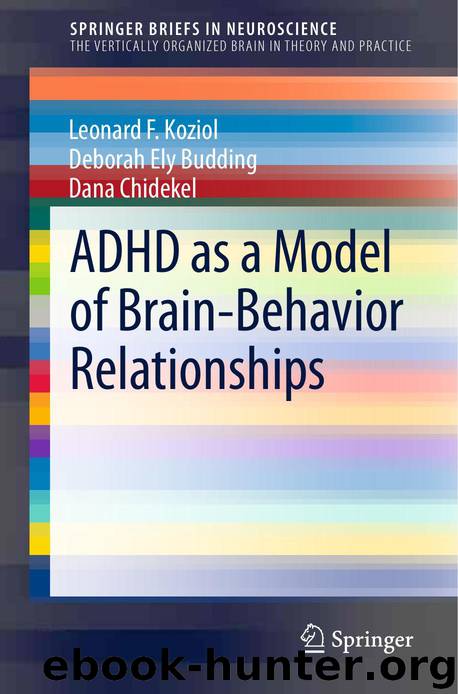ADHD as a Model of Brain-Behavior Relationships (SpringerBriefs in Neuroscience) by Leonard F. Koziol

Author:Leonard F. Koziol
Language: eng
Format: mobi
ISBN: 1461483816
Publisher: Springer
Published: 2013-09-23T21:00:00+00:00
The Modular Organization
of the Cerebellum
The cerebellum is organized along an anterior–posterior and lateral–medial gra-
dient. The anterior lobes of the cerebellum are involved in movement—typically
that which is very well practiced or automatic. The posterior regions are involved
in cognition and in learning and adapting new sensorimotor tasks and behaviors.
The medial regions of the cerebellum are involved in affective, emotional, and
motivational processes. The lateral regions of the cerebellum are involved in
cognitive processes [234, 235]. Corresponding regions of the cerebral cortex
project information to the cerebellum through the highly organized cerebro-cere-
bellar circuitry system. A simplified scheme of this circuitry system, described
above, is depicted in Fig. 1.
Prefrontal Cortex
Paralimbic Cortex
Superior
Temporal
Sulcus
Parietal Cortex
Pontine Nuclei
Cerebellum
Thalamus
Fig. 1 Simplified illustration of connections between the cerebral cortex and the cerebellum.
Koziol/Budding, 2009
L. F. Koziol et al., ADHD as a Model of Brain-Behavior Relationships,
55
The Vertically Organized Brain in Theory and Practice,
DOI: 10.1007/978-1-4614-8382-3_19, Ó The Author(s) 2013
Download
This site does not store any files on its server. We only index and link to content provided by other sites. Please contact the content providers to delete copyright contents if any and email us, we'll remove relevant links or contents immediately.
| Administration & Medicine Economics | Allied Health Professions |
| Basic Sciences | Dentistry |
| History | Medical Informatics |
| Medicine | Nursing |
| Pharmacology | Psychology |
| Research | Veterinary Medicine |
Periodization Training for Sports by Tudor Bompa(7898)
Why We Sleep: Unlocking the Power of Sleep and Dreams by Matthew Walker(6324)
Paper Towns by Green John(4770)
The Immortal Life of Henrietta Lacks by Rebecca Skloot(4233)
The Sports Rules Book by Human Kinetics(4058)
Dynamic Alignment Through Imagery by Eric Franklin(3900)
ACSM's Complete Guide to Fitness & Health by ACSM(3804)
Kaplan MCAT Organic Chemistry Review: Created for MCAT 2015 (Kaplan Test Prep) by Kaplan(3784)
Introduction to Kinesiology by Shirl J. Hoffman(3610)
Livewired by David Eagleman(3521)
The River of Consciousness by Oliver Sacks(3396)
The Death of the Heart by Elizabeth Bowen(3323)
Alchemy and Alchemists by C. J. S. Thompson(3281)
Descartes' Error by Antonio Damasio(3152)
Bad Pharma by Ben Goldacre(3075)
The Gene: An Intimate History by Siddhartha Mukherjee(2909)
The Emperor of All Maladies: A Biography of Cancer by Siddhartha Mukherjee(2894)
The Fate of Rome: Climate, Disease, and the End of an Empire (The Princeton History of the Ancient World) by Kyle Harper(2848)
Kaplan MCAT Behavioral Sciences Review: Created for MCAT 2015 (Kaplan Test Prep) by Kaplan(2802)
